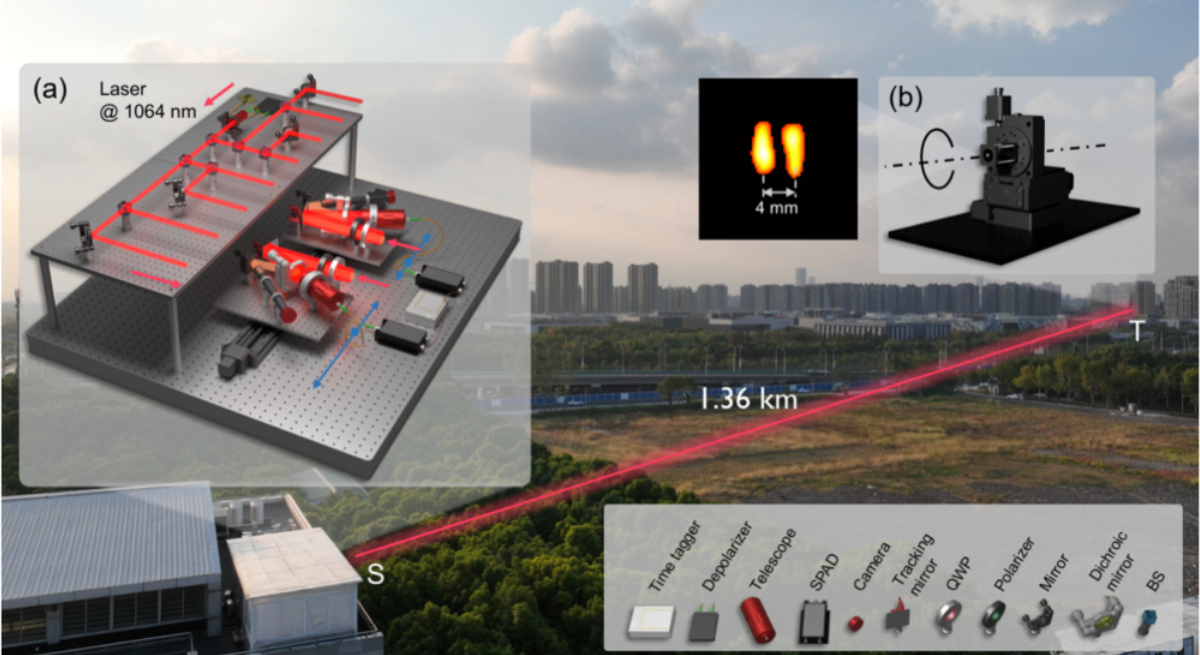

Schematic diagram of the related Active Optical Intensity Interferometry experimental system (Photo/news.ustc.edu.cn)
Chinese scientists, in collaboration with international researchers, have successfully achieved high-resolution imaging of millimeter-scale targets at a distance of 1.36 kilometers, a breakthrough that opens up new possibilities for applications such as long-range, high-precision remote sensing applications, as well as space debris detection.
Scientists from the University of Science and Technology of China, together with collaborators from the Massachusetts Institute of Technology and Xi'an Institute of Optics and Precision Mechanics of the Chinese Academy of Sciences (CAS) on Saturday published their achievement titled "Active Optical Intensity Interferometry" in the international academic journal Physical Review Letters. The paper was recommended as Editors' Suggestion, and was reported by the Physics website under the American Physical Society.
The research was achieved with a high-resolution imaging system capturing distant objects by illuminating them with laser light on them and detecting the reflected light, according to the report by the Physics.
For the first time, the researchers proposed and demonstrated active intensity interferometry for optical synthetic aperture imaging over the kilometer range, according to the paper.
The intensity interferometry technique used by astronomers to observe distant objects has now been applied by the researchers to the imaging of remote objects on Earth.
They developed a system that uses multiple laser beams to illuminate a distant target and uses a pair of small telescopes to collect the reflected light. According to the Physics website, the interferometer successfully imaged millimeter-wide letters from 1.36 kilometers away – achieving a 14-fold improvement in spatial resolution compared to a single telescope.
Traditional imaging resolution is constrained by the diffraction limit of a single telescope. To overcome this limitation, researchers have long been dedicated to developing various synthetic aperture imaging technologies, according to a statement from the University of Science and Technology of China.
In 1956, British astronomers Robert Hanbury Brown and Richard Quintin Twiss introduced intensity interferometry and successfully demonstrated the technique in measuring the star diameters of Sirius.
Intensity interferometry is insensitive to atmospheric turbulence and optical aberrations of telescopes, giving it unique advantages for long-baseline optical synthetic aperture imaging. Nevertheless, until now, intensity interferometry targets have been either bright distant objects (such as stars) or nonluminous objects that can be illuminated by a nearby source, according to the Physics website.
The team developed an intensity interferometer for remote imaging through the atmosphere. The system comprises two telescopes and an infrared laser installed on a shared optical bench. The laser light illuminates the target object, which in the team's tests was located in another building 1.36 kilometers away, Physics reported.
To showcase the system's performance, the team created a series of 8-millimeter-wide targets, each made from a reflective material and imprinted with a letter. The observations demonstrated a resolution of 3 millimeters, whereas one of the telescopes alone would have a resolution of 42 millimeter – far too poor to make out the letters, Physics reported.
The research, led by PhD candidate Liu Luchuan and postdoctoral fellows Wu Cheng and Li Wei from the University of Science and Technology of China as co-first authors, opens up new avenues for long-range, high-precision remote sensing imaging and the increasingly important task of space debris detection, according to the statement from the university. (Global Times)

86-10-68597521 (day)
86-10-68597289 (night)

52 Sanlihe Rd., Xicheng District,
Beijing, China (100864)

